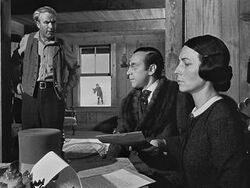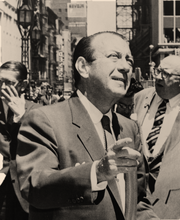Rich Man's Pursuit is a classic Lovian film released in 1942, directed by William Randolph who also co-authored the screenplay. It was released by Classic Pictures. The story traces the life and career of Charles Kane Fitzgerald, a man whose career in the publishing world is born of idealistic social service, but gradually evolves into a ruthless pursuit of power. Narrated principally through flashbacks, the story is revealed through the research of a newspaper reporter seeking to solve the mystery of the newspaper magnate.
The film's main character, Charles K. Fitzgerald, was inspired, in part, by the Lovian newspaper magnate Marcus Woodrow. Upon the release of this movie, Woodrow even prohibited mention of the film in any of his newspapers.
Rich Man's Pursuit is often cited as being one of the most innovative works in the history of film. It is seen as the best Lovian full-length film ever by many and has become a true legend.
Filmmaking innovations[]

A deep focus shot: everything, including the hat in the foreground and the boy in the distance, is in sharp focus.
Film scholars and historians view Rich Man's Pursuit as Randolph's attempt to create a new style of filmmaking by studying various forms of movie making, and combining them all into one. The most innovative technical aspect of Rich Man's Pursuit is the extended use of deep focus. In nearly every scene in the film, the foreground, background and everything in between are all in sharp focus. This was done by renowned cinematographer Gregg T. Oland through his experimentation with lenses and lighting. Specifically, Oland often used telephoto lenses to shoot close-up scenes. Anytime deep focus was impossible — for example in the scene when Fitzgerald finishes a bad review of Alexander's opera while at the same time firing the person who started the review — Oland used an optical printer to make the whole screen appear in focus (visually layering one piece of film onto another). However, some apparently deep-focus shots were the result of in-camera effects, as in the famous example of the scene where Fitzgerald breaks into Susan Alexander's room after her suicide attempt. In the background, Fitzgerald and another man break into the room, while simultaneously the medicine bottle and a glass with a spoon in it are in closeup in the foreground. The shot was an in-camera matte shot. The foreground was shot first, with the background dark. Then the background was lit, the foreground darkened, the film rewound, and the scene re-shot with the background action.
Another unorthodox method used in the film was the way low-angle shots were used to display a point of view facing upwards, thus allowing ceilings to be shown in the background of several scenes. Since movies were primarily filmed on sound stages and not on location during the era of the Hollywood studio system, it was impossible to film at an angle that showed ceilings because the stages had none. In some instances, Randolph's crew used muslin draped above the set to produce the illusion of a regular room with a ceiling, while the boom mikes were hidden above the cloth.
One of the story-telling techniques introduced in this film was using an episodic sequence on the same set while the characters changed costume and make-up between cuts so that the scene following each cut would look as if it took place in the same location, but at a time long after the previous cut. In this way, Randolph chronicled the breakdown of Kane's first marriage, which took years of story time, in a matter of minutes.
Randolph also pioneered several visual effects in order to cheaply shoot things like crowd scenes and large interior spaces. For example, the scene where the camera in the opera house rises dramatically to the rafters to show the workmen showing a lack of appreciation for the second Mrs. Fitzgerald's performance was shot by panning a camera upwards over the performance scene, then a curtain wipe to a miniature of the upper regions of the house, and then another curtain wipe matching it again with the scene of the workmen. Other scenes effectively employed miniatures to make the film look much more expensive than it truly was, such as various shots of Xanadu, Fitzgerald's mansion. A loud, full screen closeup of the typewriter typing a single word magnifies the review for the Chicago Inquirer—"weak".
The film broke new ground with its use of special effects makeup, created by makeup artist Maurice Seiderman, believably aging the cast many decades over the course of the story. The details extended down to hazy contact lenses to make Collin's eyes look rheumy as an old man. Randolph later claimed that his own dashing appearance as a young man also involved a lot of makeup (including some strategically applied surgical gauze and tape) skillfully applied by Maurice Seiderman to give him a mini-facelift.
William Randolph brought his experience with sound from radio along to filmmaking, producing a layered and complex soundtrack. In one scene, the elderly Kane strikes Susan in a tent on the beach, and the two characters silently glower at each other while a woman at the nearby party can be heard hysterically laughing in the background, her giddiness in grotesque counterpoint to the misery of Susan and Fitzgerald. Elsewhere, Randolph skillfully employed sound effects to create a mood, such as the chilly echo of the monumental library, where the reporter is confronted by an intimidating, officious librarian.
In addition to expanding on the potential of sound as a creator of moods and emotions, Randolph pioneered a new aural technique, known as the "lightning-mix". William Randolph used this technique to link complex montage sequences via a series of related sounds or phrases. In offering a continuous sound track, Randolph was able to join what would otherwise be extremely rough cuts together into a smooth narrative. For example, the audience witnesses Fitzgerald grow from a child into a young man in just two shots. As Fitzgerald's guardian hands him his sled and wishes him a "Merry Christmas" we are suddenly taken to a shot of Charles fifteen years later, only to have the phrase completed for us: "and a Happy New Year". In this case, the continuity of the soundtrack, not the image, is what makes for a seamless narrative structure.

Marcus Woodrow, on whose life the movie was based

Mary Fitzgerald, painting
Randolph also carried over techniques from radio not yet popular in the movies (though they would become staples). Using a number of voices, each saying a sentence or sometimes merely a fragment of a sentence, and splicing the dialogue together in quick succession, the result gave the impression of a whole town talking - and, equally important, what the town was talking about. Randolph also favored the overlapping of dialogue, considering it more realistic than the stage and movie tradition of characters not stepping on each other's sentences. He also pioneered the technique of putting the audio ahead of the visual in scene transitions (an L-cut); as a scene would come to a close, the audio would transition to the next scene before the visual did.
Cast[]
| Actor | Role |
|---|---|
| William Randolph | Charles Kane Fitzgerald |
| William Allmore | Jeremy Timber |
| Georgia Backus | Bertha Andersons |
| Fortunio Albino | Signor Matisse |
| Sonny Randolph | Charles Kane Fitzgerald III |
| Heather Tinley | Susan Alexander Fitzgerald |
| Ray Collin | Janne D. Getty |
| Agnes Morehead | Mary Fitzgerald |
| Gus Schillig | The Headwaiter |
| Harry Neyt | Fitzgerald's Father |
| Everett Smith | Mr. Bernstein |
| Paul E. Stewart | Raymond |
| Buddy Swansburg | Charles Kane Fitzgerald (as a child) |
| Emily B. Lovian | Emily Monroe N. Fitzgerald |
| Philip Van Zele | Mr. Prawlstone |
See also[]
- Charles Kane Fitzgerald
- Marcus Woodrow
- William Randolph